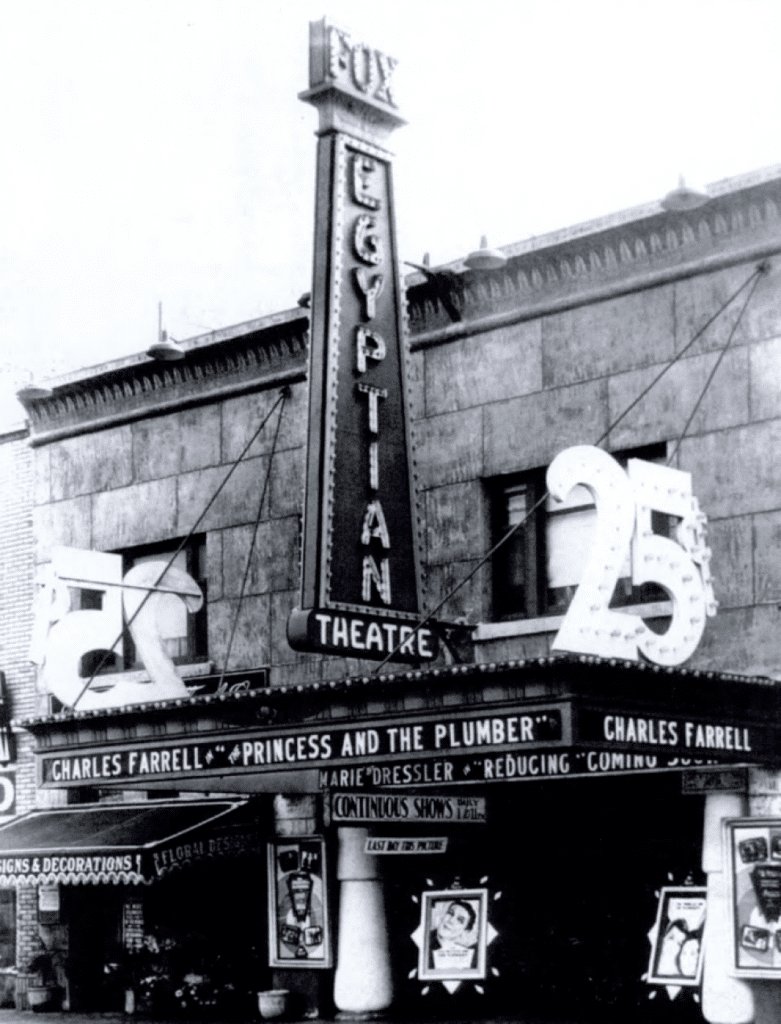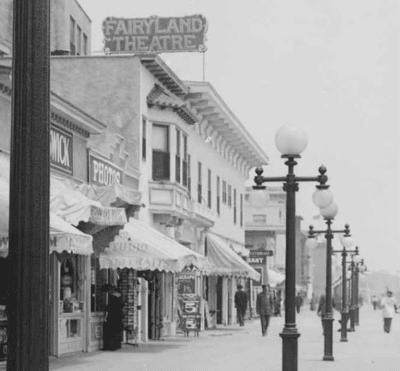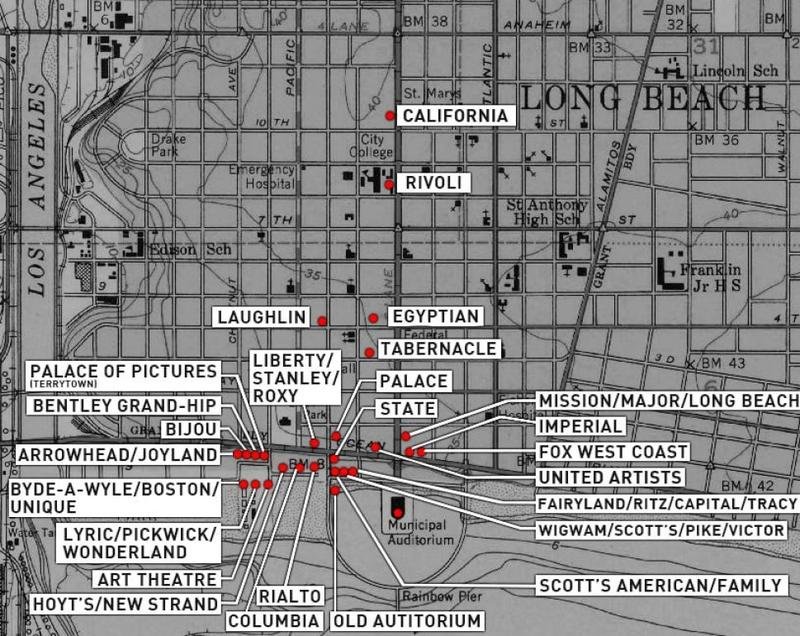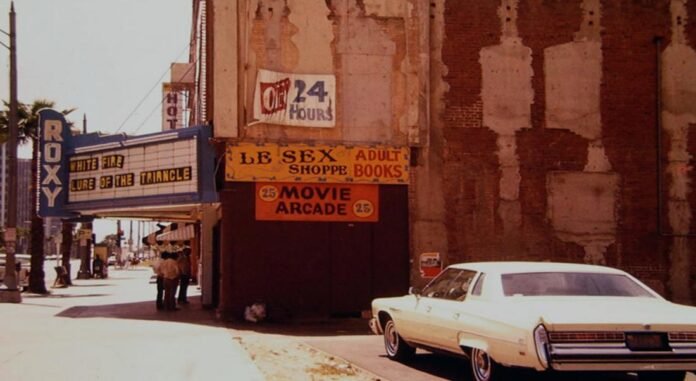Long Before a corporate taco joint began to move in and long before the now-shuttered Rock Bottom Brewery operated and long before the towering Landmark Square Building (often called the Wells Fargo Building by locals) stood in its place…
Long before Hamburger Queens—named so because their sexual favors were offered for the price of a burger—stood in the only heels they could afford, roaming its interiors and backdoors before takin’ a Naval officer for a romp…
It was the Liberty Theater that stood in the corner, opening at 127 W. Ocean Blvd. in 1916, eventually becoming the Stanley around 1930 before becoming the Roxy sometime after 1940—and it was one of several theaters that turned DTLB in a cinephile’s paradise before a downturn prompted the seedier’n’greasier side of Long Beach to come out and play.
“Few today realize that Long Beach was the center of a flourishing movie industry and could have become the film capital of the world if oil hadn’t been discovered in nearby Signal Hill.”
Like its neighbor just to the south—the Columbia Theatre, later the Strand Theatre, located along the then-dubbed Pike Avenue, and its friend to the north—the gorgeously domed Laughlin Theatre at 4th Street and Pine Avenue, the Liberty was a cog that made DTLB one of the nation’s best places for cinema as well as the movie industry with more than 25 theaters showcasing the best films during their heyday.
In fact, the first film ever shown in Long Beach was at the Tabernacle at the northeast corner of 3rd Street and Locust Avenue on June 22, 1900.
The film was an Edison picture featuring a huge combat scene along with marine scenes. Erected in the 1880s by the Chautauqua Assembly of Long Beach, the Tabernacle was the only assembly hall for the city’s 2,252 inhabitants to enjoy. It acted as both theater and church, lecture hall and event space.

With the introduction of Balboa Amusement Producing Company (Balboa Studios) in 1913—a studio that produced a staggering 1,000 films in its short existence—Long Beach’s boom in theater-building flourished as silent films starring Buster Keaton and “Fatty” Arbuckle (who rented space in the studios to create his own films) became a cultural zeitgeist.
“Few today realize that Long Beach was the center of a flourishing movie industry and could have become the film capital of the world if oil hadn’t been discovered in nearby Signal Hill,” noted historian Claudine Burnett in her seminal “Prohibition Madness: Life and Death in and Around Long Beach, California, 1920-1933.”

Come June 23, 1921, the Shell Oil Co. hit black gold with its oil find at 6th Street and Alamitos Avenue.
“Long Beach would never be the same,” Burnett wrote. “By 1923, the population of Long Beach had increased from 55,593 in 1920 to 126,8333 as thousands rushed to the area seeking employment in the new oil industry.”
The result? A drastic buy-out of land—including the lots that many films were shot in—that were demolished and subdivided into lots for new citizens. This explains the boom and then eventual fallout of movie-house building, especially after the demolition of Balboa Studios in 1925. (The studio space was used to make films until 1922.)
The first film ever shown in Long Beach was at the Tabernacle at the northeast corner of 3rd Street and Locust Avenue on June 22, 1900. The film was an Edison picture featuring a huge combat scene along with marine scenes.
Save for four theaters between 1924 and 1925—The Brayton Theatre (1925), The Ritz/Capitol/Tracy Theatre, The Egyptian Theatre (1924) and The Fox West Coast (1925)—every theater in DTLB was built during the height of its movie-making.
This wasn’t to discount what these theaters and studios provided: Between 1900 and 1910, the development of the Pike along with the addition of the Pacific Electric Railroad made Long Beach’s population surge 691%.
The main reason? People loved to be entertained—and the Pike and DTLB provided that for thousands of visitors and residents.

It was in 1910 that the California Motion Picture Manufacturing Company was created before the aforementioned Balboa Studios took over its space in 1913.
Come May 27, 1914, Balboa signed onto one of the biggest distribution deals in silent film history when it was offered exclusive distribution by William Fox, one of the America’s largest distributors of films.
That year, Balboa Studios was putting out some 300,000 feet of print per week for Fox for the Americas while Bishop, Pessers, and Co. Ltd. was distributing just as much throughout the European market. (It was the following year that Fox created Fox Films, eventually becoming 20th Century Fox, now 20th Century owned by Disney.)
However, the toll of oil, WWII, the Naval Base, and the slow death of the Pike led to the theaters becoming eradicated or turned into dark spaces for porno.
Below is a map created by Brian Addison laying out the known theaters across DTLB along with further information below it on each theatre.

Cal State Long Beach has a page dedicated to the highlights of the film industry that took over our city as well as offering a list of all known DTLB theaters, their completed-construction dates, and their capacities. Look at the list in all its sad-they’re-gone glory:
- American Theatre (circa 1912; name changed to Family Theatre by 1930)
- Address: 149 E. Seaside Way. Capacity: 450 seats
- Arrowhead Theatre (May 1911—August 1911, later renamed Joyland Theatre, 1912)
- Address: 335-341, The Pike. Capacity: 100 seats
- Art Theatre (1907)
- Address: 314-316, The Pike. Capacity: 450 seats
- Bentley Grand (1907), [renamed the Empress Grand & Hart Theatre (1917); later named the Strand Theatre)
- Address: 317-319, The Pike. Capacity: 1,500 seats
- Bijou Theatre
- Address: 333, The Pike
- Boston Theatre (1918?)
- Address: 344, The Pike
- Brayton Theatre (July 30, 1925)
- Address: 2157 Atlantic Ave. Capacity: 956 seats
- Byde-A-Wyle Theatre (March 02, 1908, later named the Unique Theatre, 1911)
- Address: 336, The Pike
- California Theatre (1921)
- Address: 1049 American Ave. (now Long Beach Blvd.). Capacity: 400-500 seats
- Columbia Theatre (1910)
- Address: 231, The Pike
- Egyptian (April 24, 1924)
- Address: 242 E. 4th St. Capacity: 1,078 seats
- Empire (1922, later named the Mission,then the Major & finally the Long Beach)
- Address: 38 American Ave. (now Long Beach Blvd). Capacity: 900 seats
- FairyLand (Dec. 1912)
- Address: 317, The Pike. Capacity: 380 seats
- Hoyt’s Pantages (1919, later named the New Strand)
- Address: 237, The PikeCapacity: 1,362 Seats
- La Petite (1907) Address: 236 Pine Ave.
- Laughlin, The (Nov. 08, 1915)
- Address: 347 Pine Ave. (corner of 4th & Pine). Capacity: 800 seats
- Liberty (1916, later named the Stanley & Roxy)
- Address: 127 W. Ocean Blvd. Capacity: 900 Seats
- Long Beach Theatre (1908)
- Address: 336, The Pike (Foot of Locust Ave.). Capacity: 1,500 seats
- Lyceum, The
- Lyric (aka Wonderland & Gayety)
- Address: 330, The Pike
- Markwell (1920, later named the State, Dec. 19, 1920)
- Address: 104 E. Ocean Blvd (inside the Jergins Trust Building). Capacity: originally 1,348 seats; later 1,800 seats
- Palace (1920, later named the Newsreel)
- Address: 30 Pine Ave. Capacity: 800 seats
- Ritz/Capitol/Tracy Theatre (April 1925)
- Address: 219 East Seaside Way. Capacity: 1,200 seats
- Tabernacle Methodist Church (1880s)
- Address: N.E. Corner, E. Locust Street & E. 3rd Street
- Tarrytown (1907; aka Palace of Pictures)
- Address: 313 Walk of a Thousand Lights (The Pike). Capacity: 800 seats
- Theatorium, The (1908; akaThe National Theatorium; later the Rialto)
- Address: 117, The Pike—west of the old Pine Avenue Pier. Capacity: 600 seats
- (Fox) West Coast Theatre, The (July 07,1925)
- Address: 333 E. Ocean Blvd. Capacity: 2,110 seats
- Wig-Wam, The (circa 1915; later named Scotts)
- Address: 207 E. Seaside Way. Capacity: 460 seats


